Bedroom Surround Sound
I link to products I like. If you buy from a link marked with * in this post, I may get a commission: about ads
Updated:
You have the AV receiver and the home theater speaker system. Now what? Get the best sound in your room with this guide to surround sound speaker placement.
Finding the best surround sound speaker placement for your room can make or break your 5.1 or 7.1 home theater system.
Don't go to all the effort of choosing the right speakers for your room – spending your hard-earned money on quality equipment – and then just put them in any old place when you get to installing them.
If you spend some time placing the speakers correctly, you will make the best of your surround sound setup.
The most important speakers are probably the center, front left and front right speakers. These are the ones that do most of the work when reproducing a movie soundtrack.
However, to get the best out of your system, getting the best possible positions for all of your surround sound speakers is important. And, the surround, rear and subwoofer speakers also play an important role.
Let's go through each speaker type and find out the essential issues for home theater speaker placement.
Center Channel Speaker Placement
The center channel speaker plays a crucial part in a 5.1 surround sound system. It is the main speaker for the dialogue in a movie, so it is crucial we place this correctly.
You should position the center speaker just above or below the middle of the TV screen – usually below – but this will depend on the height of your TV screen and if there is a suitable place to put it.
Just try not to place it too far away from the screen, or the sound may appear removed from the picture. This will sound unnatural and spoil the impact of the soundtrack.
Ideally, your primary seating position will also be central to the middle of the TV. So, the center channel speaker should be pointing directly at you.

The position above or below the screen isn't so important as the position relative to your ears.
Ideally, the speaker's tweeters should be level with your ears when sitting in your viewing position. This is because higher frequencies are more directional.
The tweeters are the small speaker cones in your speaker.
In a bookshelf or floorstanding speaker, the tweeters are usually positioned above the larger woofer speakers. However, in a center channel speaker, they are generally fitted in line with the woofers.
You may be able to remove the speaker grille if you can't see where the actual speakers are. Be careful, though!
If you can't get the speaker into a level position with your ears, try to slightly angle the speaker up or down. Just try to ensure it is pointing at your head when you are sitting down.
If possible, the tweeters of the center speaker should be the same height as the tweeters of the front left and right pair. Although, this can be difficult to achieve precisely.
Doing this will allow a more consistent sound when the audio moves across the front three speakers.

You will find that as long as they are relatively level – say within 1-2 feet – you won't notice too much of a problem when the sound pans across the speakers.
If in doubt, play a movie, watch a scene with plenty of effects moving across the front speakers, and listen to how it sounds.
Using your ears and judgment is probably the most crucial aspect of speaker placement.
Also, try not to place the speaker behind the TV's front edge, especially if it is on top. This will mean that the sound will hit the TV first, affecting the sound that reaches you.
You can use wall brackets, floor stands, or shelves to place the speaker – just try to make sure it is stable and on a solid, flat surface. In many cases, this can be the most challenging speaker to find a good position for.
If so, you might want to consider a piece of furniture designed to hold a TV and the center speaker.
A speaker designed specifically for the center will usually be a broad, horizontal shape. This should allow it to fit along the edge of a TV screen and to spread the sound evenly.
However, you can use any speaker type as your center – such as a regular bookshelf speaker. But, bear in mind the shape of this type of speaker may be more challenging to install in an ideal position.
Also, you may not get the wide soundstage that you can get with a dedicated center channel speaker. This will depend on the speaker's design.
Front Left and Right Speaker Placement
The front left and right speakers are the equivalent of the stereo pair you might use with your hi-fi system.
They handle much of the music and sound effects in a movie soundtrack but sometimes reproduce the dialogue.
Therefore, it is essential to try and balance the sound field across the front of the screen. So that the front left, center and front right speakers complement each other.
The front speakers should be an equal distance left and right of the TV – and ideally, both should be an equal distance from the primary listening position.
However, the chances are your room may not suit this exact positioning. So, in many cases, one speaker may be slightly closer than the other.
That's OK, your AV receiver will adjust the output level for small differences if necessary. Just try to make things as equal as you can and that you are as central as possible.
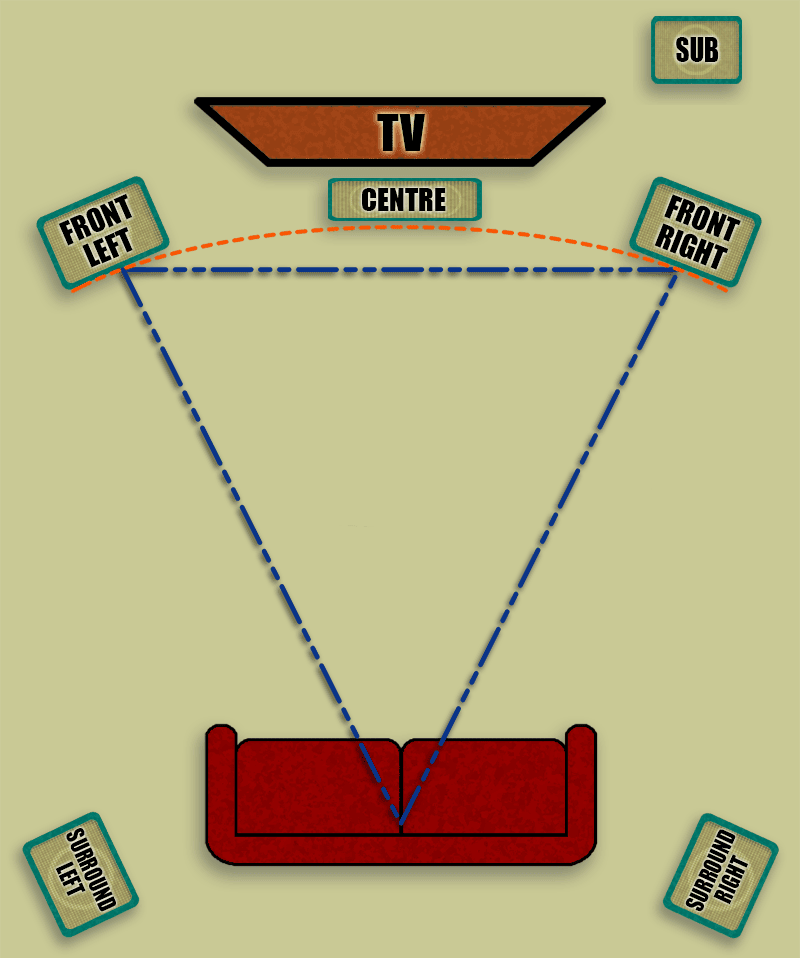
If you imagine an arc across the front of the room from your central home theater seats, you should try and get the center speaker at the top of the arc.
Then, the front left and right speakers will be slightly further forward. This ensures they will be a similar distance away from the listening position.
If this proves difficult, don't worry too much. Your AV receiver can compensate for the difference in distance between speakers.
Get as close as you can in your room, but don't start knocking walls down to get it exactly right!
The suggested range for the angle of the front left and right speakers from your sitting position is 22 to 30 degrees (see below). So, use this as a guideline when positioning the front speakers.
This angle may not be possible depending on the size and shape of your room, so don't get too distracted by the numbers.
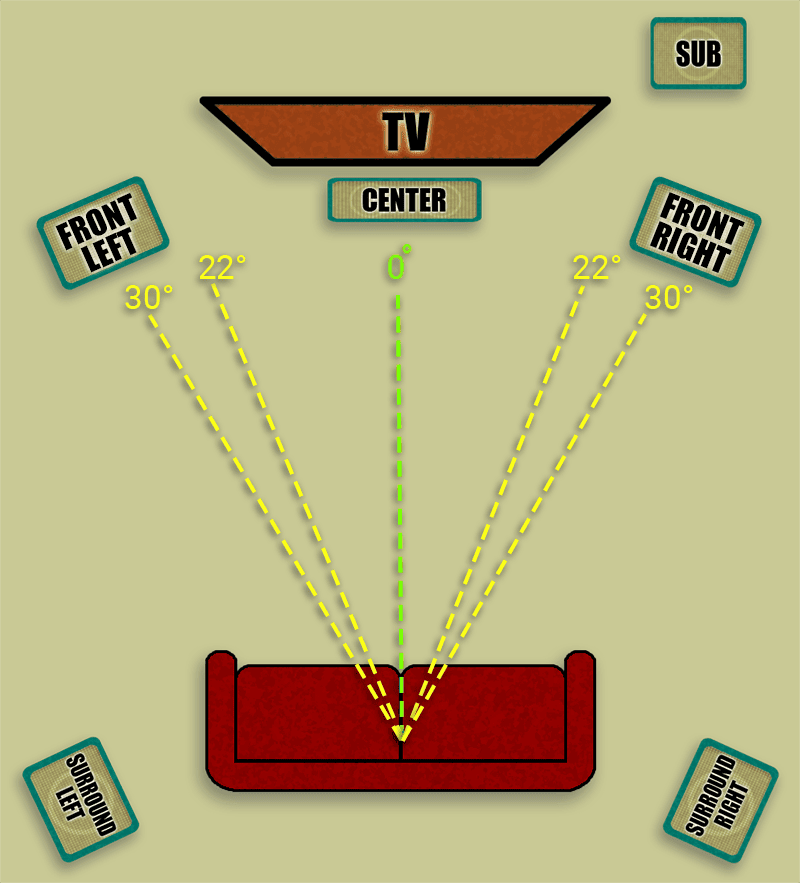
Ideally, the front speakers will have their tweeters at ear height when sitting in your viewing position. This should be about the same height as your center speaker.
If you have floorstanding speakers, then the height of the tweeter should be about right when you are sitting down. Similarly, with bookshelf speakers, your stands should create the right level.
Many people like to have the front speakers slightly angled to point at the centrally seated position. This is called 'toeing-in' the speaker.
However, this can come down to personal taste and can also vary between speakers. The best idea is to play with the angle of the speakers and decide which you prefer.
You will often get a wider soundstage if you don't toe-in the speakers – and a narrower, more focused sound if you do. But, the design of your speakers will also have a significant impact.
As with the center speaker, if you can't get the front speakers at ear height, it can be beneficial to angle them up or down towards the listening position.
Although, whether you can do this can depend on the stands or brackets you are using.
But, depending on their design, you should only position some speakers on the level, so it's up to you if you think angling them improves the sound.
Surround Speaker Positioning
The surround speakers are there to create a sense of space in your room. Ideally, the surround speakers in a 5.1 surround sound configuration should be placed just behind or to the side of your listening position.
Dolby recommends an angle of 110° to 120° from your listening position, as in the image below.
However, if that's not possible, the next best location is nearer the 90-degree angle on either side.
THX recommends between 90° to 110°, so I wouldn't feel the need to get too precise. You can put your protractor away!
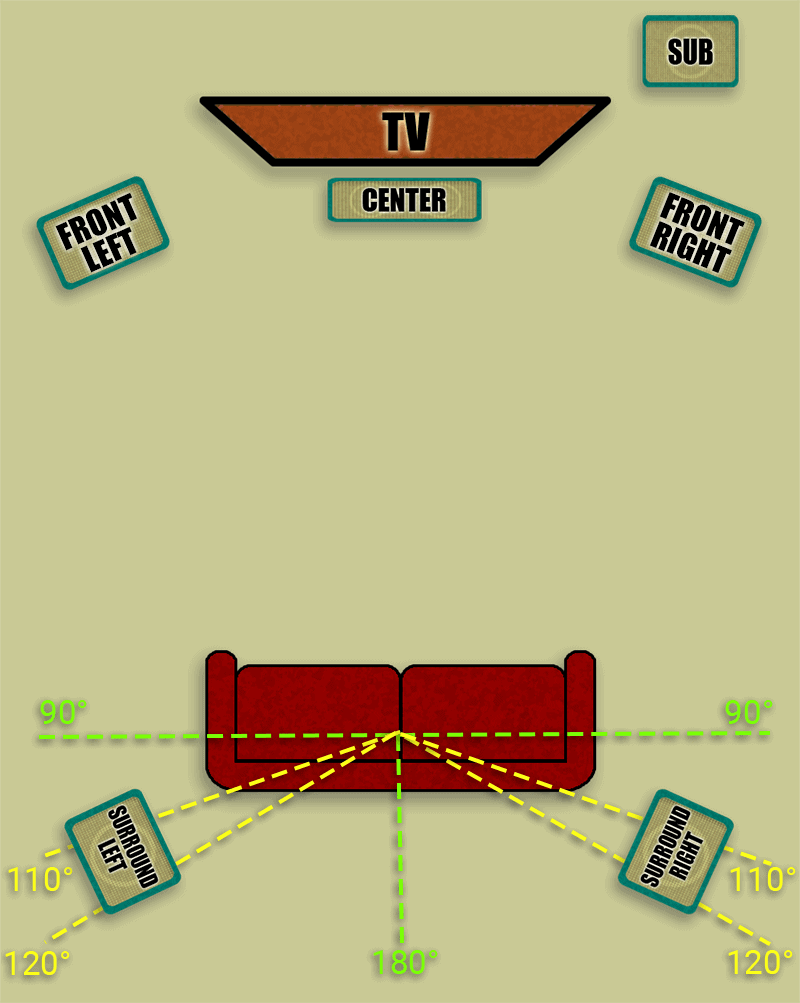
For example, if you have your couch up against a wall, you can put the surround speakers on either side at 90°.
In many rooms, you may struggle to get the exact position, but always try to get as close as your space will allow.
Depending on your room, you may have to make compromises due to the position of walls, doors, windows and furniture. But, there are usually ways to get as close as you can with a bit of thought.
The surround speakers should be slightly higher than the front speakers in the room. Ideally, about 1 to 2 feet above head height when sitting down.
This is because the surround channels are there to create an ambient sound in your room. So, you should benefit if they are slightly further away from your ears.
The idea isn't to get the direct up-front sound that we want from our front speakers.
You would usually point these speakers at the central seating location, much like the front speakers. However, this can also depend on the speaker's design – and if the stands or brackets allow.
Try angling standard direct-firing (monopole) speakers straight at your listening position.
Although, some people may find the sound a bit too direct when you do this.
Therefore, placing direct-firing speakers quite high above your main movie chair is also worth considering. This will increase the sound dispersion before it reaches your ears.
Experiment and let your ears decide which sounds the best.
It should be noted that since the introduction of Dolby Atmos speaker layouts, Dolby now suggests the surround speakers should be nearer head height/ear level.
This is so there is a distinct separation between the surround and Atmos effects. You might want to experiment with this and see what works best in your room.
If you don't have Atmos, then anything from head height to one or two feet above should work equally well once the receiver has worked its magic. However, in a small room, I think head height would feel a bit close.
The surround effects should complement the front soundstage – not compete with it.
Higher will also likely be better if you have more people in the seating area, as the people nearest the head height speakers will block the sound for others.
Remember, many people won't have the luxury of getting the speakers precisely in the recommended locations anyway.

The speaker placement for 7.1 surround sound is similar. However, the left and right surrounds should be slightly more to the side of the listening position – between 90° and 110°.
The two extra rear speakers should be behind the listening position at around 135° to 150°.
Apart from that, the height and angle of the speakers should be the same as with a 5.1 speaker system.
Bipole and Dipole Speaker Placement
If you have bipole or dipole surround speakers, then you don't need to worry about angling them – the design of these speakers will provide the ambient sound you need.
They will usually mount flat against a wall.
In a 5.1 setup, the ideal place for bipole speakers will be directly behind the listening position – pointing towards the front speakers.
Place them about 1 or 2 feet above the listener – in line with, or slightly wider than, the front speakers.
If that's not possible, the next best option is directly at either side – 90° to the listening position. Again, 1 or 2 feet higher than the listener.
For dipole speakers, the correct positions are 90° on either side of the listening position. This means the speakers in the unit will be facing to the front and back, i.e., not at the listening position.
These should also be 1 or 2 feet higher than the listener, as in the previous examples.
One advantage of bipole speakers is they are more flexible in their positioning.
In case you come across a different name, bipole speakers are also known as bipolar speakers.
This video covers some of the issues I have discussed – and highlights the compromises that are sometimes required:

Placing Dolby Atmos Speakers
A Dolby Atmos system needs to have at least two speakers that can recreate the overhead audio.
These should be installed high in your room as in-ceiling, on-ceiling or on-wall speakers – or you can buy dedicated Dolby Atmos modules that you can place on top of your existing speakers.
Traditional speakers with integrated Dolby Atmos modules are also available.
These modules will bounce the overhead audio off the ceiling toward your listening position.
For DTS:X soundtracks, there is no requirement for dedicated overhead speakers or modules, and a DTS:X soundtrack will adapt to any speaker layout.
It won't be as much fun without the height element, though.
If you are new to Dolby Atmos, check out my beginner's guide for more background information.
Does Your AV Receiver Support Atmos?
The other thing to consider before you start is the support from your AV receiver.
Firstly, the receiver will need to support Dolby Atmos and have output channels for the number of speakers you require.
Budget models will only support two Atmos speakers in addition to a 5.1 layout.
You can also install speakers for Atmos in several different locations. The common ones are:
WALL SPEAKERS
- Front Height Left/Right
- Surround Height Left/Right
- Rear Height Left/Right
CEILING SPEAKERS
- Top Front Left/Right
- Top Middle Left/Right
- Top Rear Left/Right
DOLBY ATMOS MODULES
- Front Dolby Atmos Enabled Left/Right
- Surround Dolby Atmos Enabled Left/Right
- Back Dolby Atmos Enabled Left/Right
You should always install Dolby Atmos speakers in pairs.
When you set up your receiver, you will need to tell it what type of Dolby Atmos speakers you have installed in your room – and where they are.
Then the receiver will adjust the delivery of a soundtrack to suit your installation.
But, not all receivers will support all the possible locations – so check this before you go drilling holes in your ceiling!
Positioning Your Dolby Atmos Speakers
With the introduction of Atmos audio, Dolby introduced a slightly different concept for home theater sound – listener level audio and overhead audio.
Listener level speakers are the standard 5.1/7.1 surround speakers and ideally, these should be roughly the same height and placed around ear level.
This leaves space above for the Atmos overhead audio plane. When combined, this will produce a thrilling 3D audio experience in your room.
If the overhead speakers are mounted on the ceiling and pointed directly down, they should have a wide dispersion pattern of around 45 degrees (from 100 Hz to 10 kHz).
For speakers with a narrower soundstage, these should be angled towards the primary listening position.
Ideally, you should install the overhead speakers at around 2 to 3 times the height of the listener level speakers. While these are only guidelines, try to get as close as you can in your room.
The main thing is to get a good separation between the listener level and overhead speakers – although not too far, or the audio will become disconnected and won't be as immersive.
As already mentioned, the minimum number of overhead speakers for Dolby Atmos is two – although Dolby recommends four.
While several speaker locations are supported, with four overhead speakers, the suggested places to use are:
- Top Front Left/Right
- Top Rear Left/Right
As in the picture here:

As you can see, ideally, you should center the position of the overhead speakers around the listening position.
But this does require support from your AV receiver for these locations – and enough space in your room. If you don't have either of these, then you can choose a different layout.
Another thing to consider is the speaker type. The ideal type of speaker for the top front, middle and rear locations are in-ceiling speakers. This is because they are intended to be directly overhead.
However, many people can't (or don't want to) cut holes in their ceiling to install speakers. If so, you can consider using conventional speakers that you fix to the ceiling.
Or, why not try putting speakers on the sidewalls and angling them down to the main listening position?
You can still tell the receiver these are top-positioned speakers. Or, if supported by your receiver, you can identify them as surround and rear height speakers.
This isn't exactly as intended, but if you bend the rules a little you can still get a great 3D effect in your room. Try it and see what sounds best to you.
With four speakers, the recommended angle from the listening position is 45 degrees to the top front and rear speakers.
Although this can be increased to between 30 and 55 degrees if necessary.
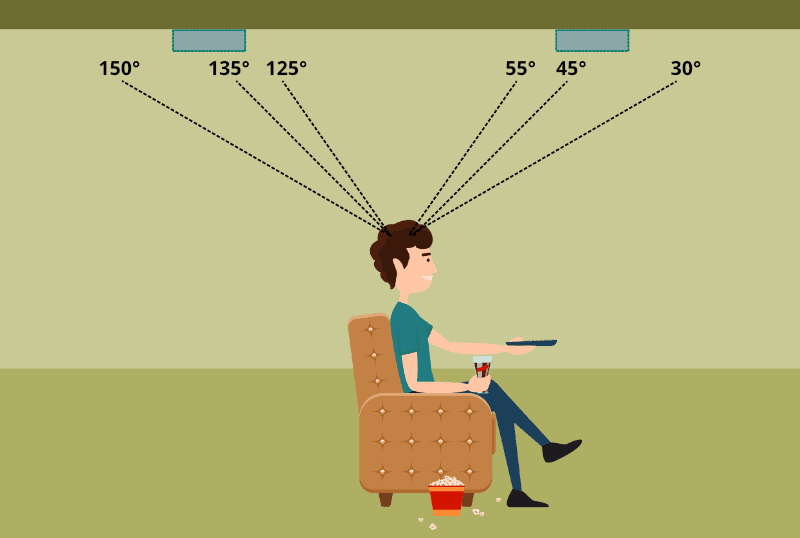
If you only install two overhead speakers, Dolby recommends using the top middle left and right speaker position.
This should be 65° to 100° above your listening position. So, anything from just in front of you, to directly overhead or slightly behind.
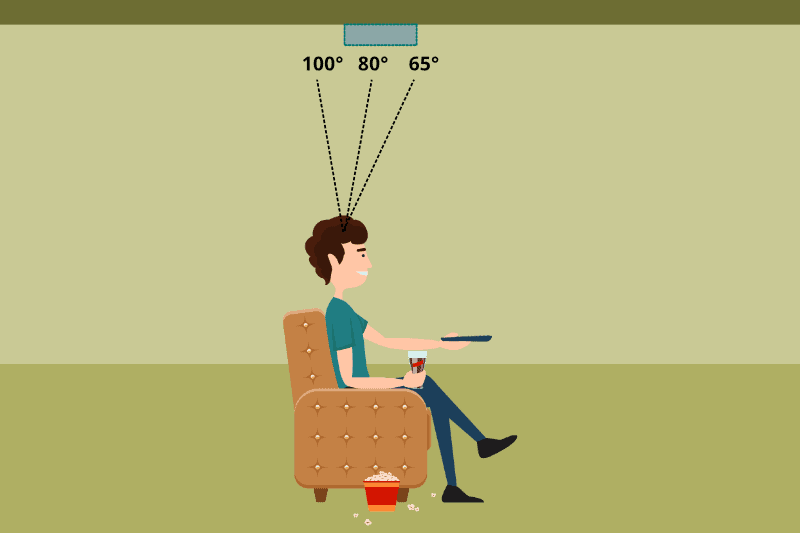
But, you don't have to. You could install two front height left/right speakers if you prefer. Or any of the other locations.
If you don't want to install overhead speakers at all, buying Dolby Atmos enabled modules – or speakers with integrated Dolby Atmos drivers – is a good solution.
They can also be easier to install.
The idea is you place the modules around ear-level, and they direct the audio towards your ceiling. This creates a diffuse overhead sound when it reflects down to your listening position.
The recommended position of the modules is slightly different from overhead speakers. If you only have two Dolby Atmos modules, then it is recommended to place these on, or near, your front left and right speakers.
If you want four modules, you should place the rear pair on, or near, the rear back surrounds in a 7.1 system – and on/near the rear surrounds in a 5.1 system.
There are a few other guidelines that you should bear in mind if you want to consider using this type of speaker. When you install Dolby Atmos enabled speakers you should:
- make sure the room height is between 7.5 and 14 feet
- ensure that the ceiling is made of a reflective material like plaster, drywall or hardboard
- place them at, or slightly above, ear level
- install them no higher than one-half the room height
As long as you can follow these points then you should get an effective overhead sound using Atmos modules.
Positioning Dolby Atmos speakers is more complicated than with traditional 5.1 and 7.1 systems.
The beauty is you can go from a 2.1.2 layout to 7.1.4 to 11.1.8 and beyond – and use a combination of overhead speakers and modules.
The recommended location for the Dolby Atmos speakers does vary slightly between each layout, but they do follow the same basic principles.
But, you can also just place your speakers where they will fit and still get a pretty good immersive experience. Don't be afraid to experiment and decide for yourself what sounds best in your room.
You can also go to the Dolby website for more detailed information on more Atmos layouts.
If you are having problems with your Atmos speakers after you have installed them, check out my guide to fixing problems with your Dolby Atmos speakers.
Placement of the Subwoofer
The subwoofer is the maverick of surround sound speakers. It's the cool guy who goes where he wants and doesn't follow the same rules as everybody else.
The main reason for this is the subwoofer has a specific job – to reproduce the really low bass in a soundtrack.
Low bass frequencies are not as directional as higher frequencies due to their long wavelength. This means that it is harder to tell where the sound is coming from in the room.
Therefore, subwoofer placement in a room is much less critical than with other speakers – which can be a blessing given the size of the darn thing!
Wherever you have a spare bit of space in your room, then you can pretty much stick it anywhere.
Although, there are a few general guidelines worth considering if you can.

In general, avoiding the corners of a room can be important for the subwoofer. This is because the bass frequencies can become 'boomy' by being in the corner.
Having said that, you can sometimes use a position near the corners of a room to your advantage and boost the bass sound from your subwoofer. Your neighbors might not be so pleased though!
The potential disadvantage is the bass becomes too overpowering in the room and harder to control.
Have a play around with the position and see what you think. You will have to try this for each room as no two rooms will sound the same.
One thing to listen out for is areas of the room where the bass is especially quiet – or loud. Because of the long wavelength of bass sound waves, it is easy to create standing waves in a room.
This can cause the bass volume to vary throughout a room as the sound waves add together – or cancel out.
The shape of your room can also affect the creation of standing waves – and a square-shaped room can be a particular problem as the walls will be the same distance apart.
So, try to avoid placing the subwoofer at an equal distance between two opposite walls. Doing this can result in the reflecting waveforms canceling each other out.
Therefore, don't have the speaker precisely in the middle of the room – ideally, it would be best to place the subwoofer nearer one end or the other.
The main thing to check is that a drop in the bass isn't happening around the listening area, which is not what we want. If you find this is happening, then you can move the subwoofer a bit. Just a few inches may do it.
This can drastically improve the bass levels in the critical listening area.
Another common way of finding the best subwoofer position for your room is to do the 'subwoofer crawl.'
For this, you need to place the subwoofer in the primary listening position (you may need a long cable for this) and then get on your hands and knees and crawl around the room while listening to some audio content.
When you hear where the bass sounds the best to your ears, you can put the subwoofer there.
Another solution, especially for a large room with a few quiet areas, is a 5.2 or 7.2 setup with an extra subwoofer.

A second subwoofer can help level out the bass throughout a room – especially in the crucial areas where people are sitting.
For the best results, you would have to move the subwoofer positions around your room and listen for a change in the bass levels. You are looking for a consistent level of bass at all listening positions in the room.
There isn't going to be a perfect position for the second sub that will suit all rooms.
One trick is to have one person sitting in the listening position and another to move the subwoofers around. You may be surprised at how much difference a few inches one way or another can make.
As you might guess, the downside of a 7.2 setup is that it can be harder to set up a room with two subwoofers. The low-frequency bass sound waves from two different places could start to cancel each other out.
So, you could end up making the bass sound in the room worse!
Plus, it can be more challenging to wire two subwoofers. There are more cables to run.
And, does your receiver even support two subs? See my guide to hooking up a subwoofer if you want to know more about this.
Once you get into this kind of territory, then you might want to hire an expert with sound meters to test the room and position the subs properly.
However, try giving it a go yourself first, use your ears and listen to the effect of moving the subs around.
General Speaker Placement Guidelines
So far, I have looked at the placement of specific home theater speakers.
If you want to understand more about the different speaker types, you might want to take a look at the article 'Best Home Theater Speakers in 2021: Buying Guide & Reviews.
In terms of general guidelines, you should bear in mind the following points when positioning your speakers.
Remember, it's not the end of the world if you don't follow them to the letter.
But, the nearer you can get, the more chance you have of getting a great sound in your room.
1. Every Room Is Different
The first thing to remember is that your room will probably not be the perfect shape for a home theater sound system.
Most of us will be using a communal living area for our home theater equipment, so it is tough to get the perfect setup.
However, that doesn't mean that we can't try to get the best sound possible from our amplifier and speakers. While you may not be able to get every point exactly right, you will still be making the best use of the space you have available.
Most people will have to make some compromises in the location of their speakers. That's fine, just aim to do the best job you can. It will make a big difference to the sound in your room.

Once you have the speakers in the best location you can, you can adjust the settings of your AV receiver with volume, phase and tonal balancing.
This can help to compensate for the actual position of each speaker in the room.
Most modern AV receivers will have some form of automatic room correction, which you can run using the supplied microphone.
This can be very effective, and you can still manually tweak the settings afterward to your taste if you prefer.
2. Not Too Close to Walls, Floors and Ceilings
I've already mentioned this for the subwoofer, but it holds for all of your speakers. Try to avoid placing the speakers too close to walls, floors and ceilings.
This can be difficult in smaller rooms, but you will alter the speakers' sound if they are too close to these surfaces.
The bass will increase if too close to walls or floors, which will artificially change your speakers' sound.
Also, the sound waves can reflect off these hard surfaces and delay the sound waves reaching your listening position. This can create poor clarity and stereo imaging.
However, just to confuse you, some smaller speakers may benefit from placement on or near walls. Some are designed to use this increase in the low-end to help their sound.
This is because they are too small to get a good bottom end on their own.
Check out the information that comes with the speaker if you are not sure.
As a general guideline, the bigger the speaker, the more bass it creates on its own. It will be more important to keep these away from the walls.
3. Avoid Corners
Try to avoid placing the speakers in corners.
This is like point 2 – except the issues are even more of a problem to the sound – because it is where the floor, wall and ceiling meet.
The corner of a room can do strange things to the sound waves bouncing around your room, especially the bass end. The bass will often appear 'boomy' or 'muddy' if your speakers are too close to the corner.
Having said that, I'm now going to contradict myself completely.
In some rooms, you can try placing the subwoofer near the corner to boost the bass in the room.
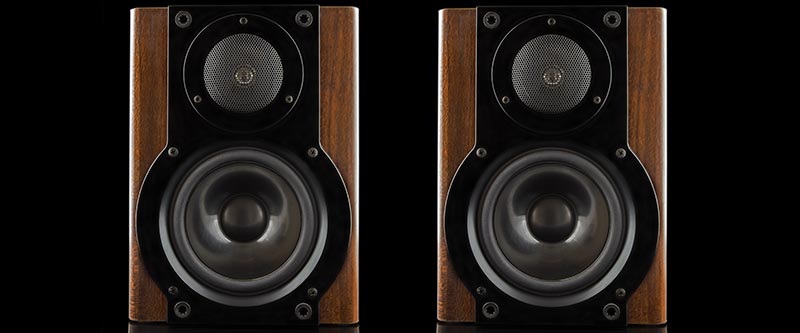
If you aren't getting the type of bass you want, putting the subwoofer there might give the bottom end a tone that you like.
Just be aware that this could also result in excessive bass, which is hard to control.
Speaker placement can be full of seemingly conflicting advice. But, the truth is each room is different, and something that works well in one room may not work in another.
Experiment and listen!
4. Avoid Obstructions
Always try to make sure nothing is getting in the way of the sound reaching your ears.
You won't get the best sound from your speakers if the furniture, curtains, and even your TV itself obstruct the sound from getting to you.
Obstructions will cause the sound waves to bounce around the room before reaching you.
Ideally, what you want is for the sound to go directly from the speaker to your ears.
Even if your speakers are sitting on a shelf – try to move them forward a little – so the speaker's front is in line with the edge of the shelf.
Maybe even overhang them a touch. Not too much, though, or they might fall off! Half an inch is plenty.
The main thing to avoid is the speaker being pushed back into the shelf itself.
This will ensure that the sound from the speaker doesn't reflect off the hard surface as soon as it leaves the speaker.
This issue can be a particular problem for your center speaker. It is common to have these on a shelf below the TV.
Just make sure it is pushed right to the front edge and so it pushes the sound directly at your listening position.
5. Try a Listening Test
Play a constant sound – like a piece of music you know well – and sit in your normal listening position. Listen carefully to the sound.
Then, move the speakers by a few inches, or change the angle they are pointing, and hear how this affects the sound.
This is easier if there are two of you – one to listen and one to move the speakers.
It may surprise you how moving the speakers by a small amount can alter the sound.
This can be especially useful when finding the correct position for the subwoofer. You have more freedom where to place the sub, so you can experiment more.
Conclusion
Follow these guidelines, and you will be well on your way to the best speaker placement for your surround sound system.
The main thing to remember is that they are just that – guidelines. Don't feel that you must follow each point strictly.
Get as close as you can – depending on the dimensions of your room and the type of speakers.
The center and front speakers are crucial to a surround sound system. These should receive most of your attention. Get this right, and you will be well on the way.
However, it is easy to forget about the surround, rear and subwoofer speakers. The correct surround speaker placement is crucial if you want to get the best out of your speaker system.
When they are all in the best locations, they will work together to give you a great surround sound experience.
Please don't waste the potential of your home theater sound system by not giving it a chance to sound its best.
Frequently Asked Questions
This article covers quite a bit of ground, but there is always more to learn about placing surround sound speakers. Here are the answers to some common questions.
How High Should the Surround Sound Speakers Be?
In a traditional 5.1 and 7.1 speaker system, the recommendation for surround speakers is one or two feet above ear level. Since the introduction of Dolby Atmos audio, Dolby now refers to the 5-channel and 7-channel speakers as being at listener level – and suggests these should all be at ear-level for the listener. This is to create a distinct separation between the listener-level audio and the Atmos height audio. However, these aren't hard and fast rules, so you can place the surrounds higher than this. Although, in this case, Dolby recommends a height of no more than 1.25 times the height of the front speakers. These are only guidelines. You can deviate from this if your room layout is challenging.
How Far Back Should the Rear Surround Speakers Be?
There isn't a specific distance for the rear surround speakers in a 7.1 speaker layout. However, it would be best to keep relatively close to help the immersive sound experience. The recommendation is for the rear surround speakers to be around 135° to 150° from the listening position and roughly in line with the front left and right pair.
Does Surround Sound Speaker Height Matter?
Yes, to get the best immersive experience, you want to follow the guidelines as best you can. For 5.1 and 7.1 systems, the surrounds should be from ear level to 1 or 2 feet above. For a Dolby Atmos system, Dolby recommends that you have the standard surround speakers at ear level (listener level) – and the Dolby Atmos overhead speakers at two to three times the height of the listener level speakers.
Do I Need Overhead Speakers in a Dolby Atmos Speaker System?
Dolby says the overhead sound is integral to the Dolby Atmos audio experience. Therefore you must have speakers capable of creating the Dolby Atmos sound field. Overhead speakers can be in-ceiling, on-ceiling, in-wall or on-wall – or you can place Dolby Atmos-enabled modules on top of your existing listener level speakers. DTS:X soundtracks don't insist on having overhead speakers, so DTS:X will adapt to any speaker layout.
How to Install 7.1 Surround Sound with a Couch Against the Wall?
The easiest answer is simply to stick with a 5.1 surround sound system and put the surrounds at 90° to your sitting position. The rear surrounds in a 7.1 layout really should be a distance behind you, which you can't do when the couch is against the wall. If you really want to try it, you could try installing in-ceiling speakers above you, in-wall speakers behind you, or maybe try bipole/dipole speakers attached to the back wall. But neither solution is ideal, and you will probably be better off setting up an outstanding 5.1 system than trying to hack a 7.1 layout.
Pin Me!


About Home Cinema Guide
Paul started the Home Cinema Guide to help less-experienced users get the most out of today's audio-visual technology. He has worked as a sound, lighting and audio-visual engineer for around 20 years. At home, he has spent more time than is probably healthy installing, configuring, testing, de-rigging, fixing, tweaking, re-installing again (and sometimes using) various pieces of hi-fi and home cinema equipment.
I link to products I like. If you buy from a link marked with * in this post, I may get a commission: about ads
Source: https://www.the-home-cinema-guide.com/surround-sound-speaker-placement.html

0 Komentar